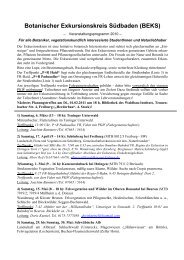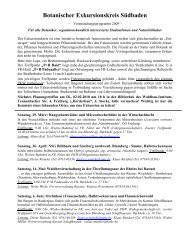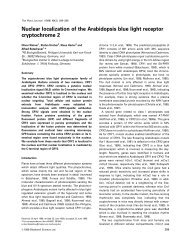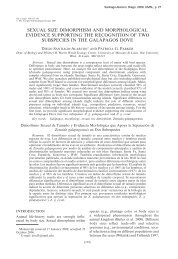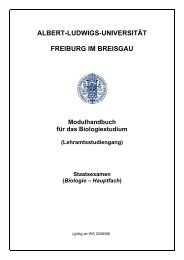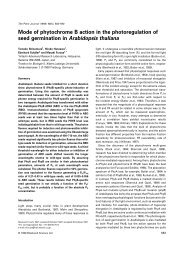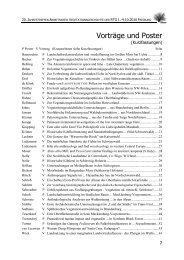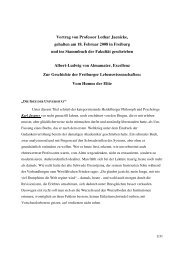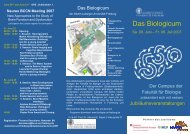Light-controlled growth of the maize seedling mesocotyl: Mechanical ...
Light-controlled growth of the maize seedling mesocotyl: Mechanical ...
Light-controlled growth of the maize seedling mesocotyl: Mechanical ...
You also want an ePaper? Increase the reach of your titles
YUMPU automatically turns print PDFs into web optimized ePapers that Google loves.
Fig. 1. Elongation kinetics <strong>of</strong> MEZ <strong>of</strong> intact <strong>maize</strong> <strong>seedling</strong>s in<br />
darkness and blue light. Ten-millimeter sections directly below <strong>the</strong><br />
coleoptilar node <strong>of</strong> 4-day-old dark-grown <strong>seedling</strong>s were marked<br />
and <strong>the</strong>ir increase in length followed over a period <strong>of</strong> 24 h in<br />
darkness, continuous light or after transferring <strong>the</strong> <strong>seedling</strong>s to<br />
darkness after 3 or 12 h <strong>of</strong> light.<br />
by red (660 nm), far-red (730 nm) and blue (450 nm) light<br />
within less than 3 h after <strong>the</strong> onset <strong>of</strong> irradiation. As<br />
reported previously for <strong>the</strong> hypocotyl <strong>of</strong> etiolated dicot<br />
<strong>seedling</strong>s (Cosgrove 1988, Kigel and Cosgrove 1991), blue<br />
light produced a particularly rapid and strong inhibitory<br />
effect; <strong>the</strong>refore, this light quality was utilized for fur<strong>the</strong>r<br />
investigations. Marking experiments confirmed that <strong>the</strong><br />
maximal elongation rate occurs in <strong>the</strong> upper 5-mm zone <strong>of</strong><br />
<strong>the</strong> MEZ and slows down to zero at <strong>the</strong> lower end <strong>of</strong> <strong>the</strong><br />
subtending 5-mm zone (Yahalom et al. 1987). Therefore, a<br />
10-mm segment below <strong>the</strong> node containing <strong>the</strong> entire MEZ<br />
was used for investigating <strong>the</strong> effect <strong>of</strong> blue-light irradiation<br />
Fig. 2. Load/extension curves<br />
measured with <strong>the</strong> cell walls<br />
<strong>of</strong> MEZ tissue from 4-day-old<br />
dark-grown <strong>maize</strong> <strong>seedling</strong>s<br />
irradiated with blue light or<br />
kept in darkness for 18 h.<br />
Frozen/thawed, hydrated<br />
segments were subjected to a<br />
loading (upward arrows) and<br />
unloading (downward arrows)<br />
cycle. The load was increased<br />
and <strong>the</strong>n decreased by<br />
consecutively adding and<br />
removing 5 loads <strong>of</strong> 8g(78<br />
mN) each in 1-min intervals<br />
and recording <strong>the</strong> extension in<br />
an extensiometer. (a) Absolute<br />
extension; (b) extension<br />
normalized to maximal<br />
extension at 40 g load. For<br />
comparison, <strong>the</strong> dotted lines<br />
in (a) were determined by<br />
stretching MEZ segments at<br />
constant rate and measuring<br />
<strong>the</strong> increase in load in <strong>the</strong><br />
Instron machine (see Fig. 3).<br />
The curves for increasing load<br />
obtained with <strong>the</strong> two<br />
methods are very similar.<br />
on <strong>mesocotyl</strong> <strong>growth</strong>. The elongation kinetics <strong>of</strong> this segment<br />
in darkness and blue light are shown in Fig. 1. In<br />
darkness <strong>the</strong> MEZ produces about a 50-mm increase in<br />
<strong>mesocotyl</strong> length during 24 h. Continuous light inhibits this<br />
<strong>growth</strong> almost completely. However, if <strong>the</strong> <strong>seedling</strong>s are<br />
transferred back to darkness after 3 h <strong>of</strong> irradiation, <strong>the</strong><br />
MEZ activity progressively recovers after a lag <strong>of</strong> 6hand<br />
approaches <strong>the</strong> dark rate after a fur<strong>the</strong>r 12 h. No <strong>growth</strong><br />
recovery can be observed within <strong>the</strong> next 12 h if <strong>the</strong><br />
<strong>seedling</strong>s are returned to darkness after 12 h <strong>of</strong> irradiation.<br />
Thus, it appears that <strong>the</strong> reversibility <strong>of</strong> <strong>the</strong> light-mediated<br />
<strong>growth</strong> inhibition in <strong>the</strong> MEZ disappears during prolonged<br />
irradiation periods.<br />
For examining whe<strong>the</strong>r <strong>the</strong> light-mediated changes in<br />
<strong>growth</strong> rate shown in Fig. 1 can be related to corresponding<br />
changes in mechanical cell-wall properties, <strong>the</strong> MEZ was<br />
excised and <strong>the</strong> stiffness <strong>of</strong> <strong>the</strong> longitudinal cell walls was<br />
measured with rheological tests commonly used for determining<br />
<strong>the</strong> elastic or viscoelastic behavior <strong>of</strong> solid materials.<br />
Fig. 2 shows <strong>the</strong> effect <strong>of</strong> blue light on wall stiffness revealed<br />
by load/extension curves determined in <strong>the</strong> extensiometer<br />
after irradiating <strong>the</strong> <strong>seedling</strong>s for 18 h. The longitudinal cell<br />
walls <strong>of</strong> both light-grown and dark-grown MEZ segments<br />
demonstrate closed hysteresis loops typical for viscoelastic<br />
materials (Vincent 1990). Blue light strongly reduces <strong>the</strong><br />
extension per unit load on an absolute scale (Fig. 2a),<br />
whereas <strong>the</strong> relative width <strong>of</strong> <strong>the</strong> loop is little affected (Fig.<br />
2b). Thus, light appears to induce an increase in wall<br />
stiffness without qualitatively affecting <strong>the</strong> inherent viscoelastic<br />
material properties. A similar light-mediated increase<br />
in wall stiffness has been observed in rye coleoptiles<br />
(Kutschera 1996).<br />
Basically, similar light-dependent differences in <strong>the</strong> stress/<br />
strain behavior <strong>of</strong> MEZ cell walls were obtained by <strong>the</strong><br />
inverse measurement <strong>of</strong> this relationship in <strong>the</strong> Instron<br />
testing machine (dotted lines in Fig. 2a). This technique was<br />
Physiol. Plant. 111, 2001 85




